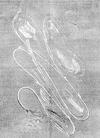- art nouveau
-
/ahrt' nooh voh", ahr'/; Fr. /annrdd nooh voh"/, (often caps.) Fine Arts.a style of fine and applied art current in the late 19th and early 20th centuries, characterized chiefly by curvilinear motifs often derived from natural forms.[1900-05; < F: lit., new art]
* * *
Decorative style that flourished in western Europe and the U.S. с 1890–1910.The term was derived in 1895 from a gallery in Paris called L'Art Nouveau. Characterized by sinuous, asymmetrical lines based on plant forms, the style was used in architecture, interior design, graphic art and design, jewelry, and glass. It was international in scope, with celebrated exponents in England (Aubrey Beardsley), Paris (Alphonse Mucha), the U.S. (Louis Comfort Tiffany), Scotland (Charles Rennie Mackintosh), Spain (Antonio Gaudí), and Belgium (Victor Horta). The style did not significantly survive the outbreak of World War I. See also Arts and Crafts Movement; Jugendstil. "The Whiplash," Art Nouveau tapestry by Hermann Obrist, silk embroidered on wool, 1895; ...By courtesy of the Munchner Stadtmuseum, Munich
"The Whiplash," Art Nouveau tapestry by Hermann Obrist, silk embroidered on wool, 1895; ...By courtesy of the Munchner Stadtmuseum, Munich* * *
▪ artistic styleornamental style of art that flourished between about 1890 and 1910 throughout Europe and the United States. Art Nouveau is characterized by its use of a long, sinuous, organic line and was employed most often in architecture (Western architecture), interior design, jewelry and glass design, posters, and illustration. It was a deliberate attempt to create a new style, free of the imitative historicism that dominated much of 19th-century art and design. Art Nouveau developed first in England and soon spread to the European continent, where it was called Jugendstil in Germany, Sezessionstil in Austria, Stile Floreale (or Stile Liberty) in Italy, and Modernismo (or Modernista) in Spain. The term Art Nouveau was coined by a gallery in Paris that exhibited much of this work.In England the style's immediate precursors were the Aestheticism of the illustrator Aubrey Beardsley (Beardsley, Aubrey), who depended heavily on the expressive quality of organic line, and the Arts and Crafts Movement of William Morris, who established the importance of a vital style in the applied arts. On the European continent, Art Nouveau was also influenced by experiments with expressive line by the painters Paul Gauguin and Henri de Toulouse-Lautrec. The movement was also partly inspired by a vogue for the linear patterns of Japanese prints (ukiyo-e).The distinguishing ornamental characteristic of Art Nouveau is its undulating, asymmetrical line, often taking the form of flower stalks and buds, vine tendrils, insect wings, and other delicate and sinuous natural objects; the line may be elegant and graceful or infused with a powerfully rhythmic and whiplike force. In the graphic arts the line subordinates all other pictorial elements—form, texture, space, and colour—to its own decorative effect. In architecture and the other plastic arts, the whole of the three-dimensional form becomes engulfed in the organic, linear rhythm, creating a fusion between structure and ornament. Architecture particularly shows this synthesis of ornament and structure; a liberal combination of materials—ironwork, glass, ceramic, and brickwork—was employed, for example, in the creation of unified interiors in which columns and beams became thick vines with spreading tendrils and windows became both openings for light and air and membranous outgrowths of the organic whole. This approach was directly opposed to the traditional architectural values of reason and clarity of structure.There were a great number of artists and designers who worked in the Art Nouveau style. Some of the more prominent were the Scottish architect and designer Charles Rennie Mackintosh (Mackintosh, Charles Rennie), who specialized in a predominantly geometric line and particularly influenced the Austrian Sezessionstil; the Belgian architects Henry van de Velde (Velde, Henry van de) and Victor Horta (Horta, Victor, Baron), whose extremely sinuous and delicate structures influenced the French architect Hector Guimard (Guimard, Hector), another important figure; the American glassmaker Louis Comfort Tiffany; (Tiffany, Louis Comfort) the French furniture and ironwork designer Louis Majorelle; (Majorelle, Louis) the Czechoslovakian graphic designer-artist Alphonse Mucha; (Mucha, Alphonse) the French glass and jewelry designer René Lalique; (Lalique, René) the American architect Louis Henry Sullivan (Sullivan, Louis), who used plantlike Art Nouveau ironwork to decorate his traditionally structured buildings; and the Spanish architect and sculptor Antonio Gaudí, perhaps the most original artist of the movement, who went beyond dependence on line to transform buildings into curving, bulbous, brightly coloured, organic constructions.After 1910 Art Nouveau appeared old-fashioned and limited and was generally abandoned as a distinct decorative style. It was important, however, in moving toward the 20th-century aesthetic of unity of design.* * *
Universalium. 2010.
